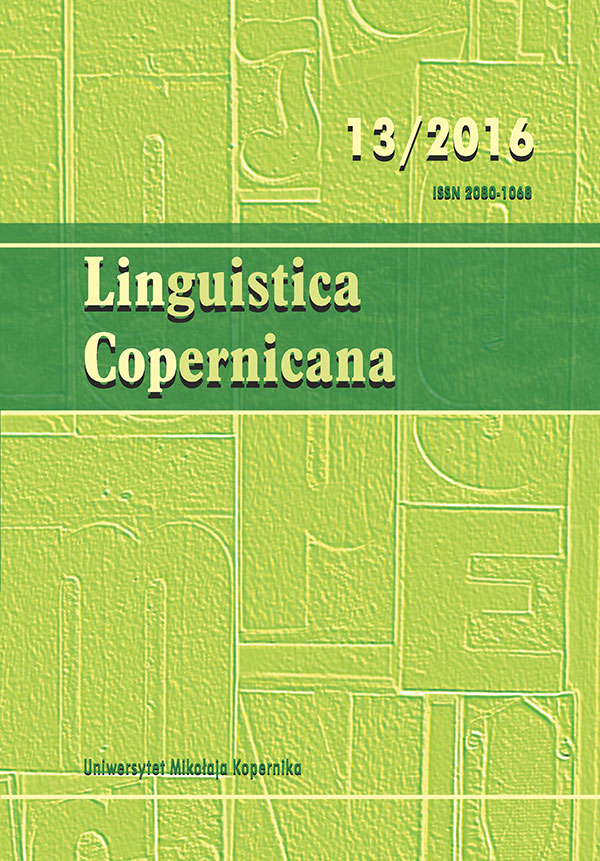An insight into the history of Balkan Slavic languages. Macedonian perspective
DOI:
https://doi.org/10.12775/LinCop.2016.002Keywords
accelerated evolution, contact changes, communicative hierarchyAbstract
The aim of this article is to point to the main processes that contributed to the linguistic evolution of the South-Eastern Slavic (i.e. Macedonian and Bulgarian language dialects as well as some of the dialects of the Southern Serbia) veering off the way in which the other, more conservative, of the Slavic dialectical complexes developed. In the case of the South-Eastern Slavic, the development has been to a considerable extent driven by the so called contact changes, i.e. by the interference between languages of different typological compositions in a multilingual administrative structures that impose on the individuals not fluent in their speakers’ language the need to communicate. In consequence, this type of development uncovers the right communicative hierarchy of the transferred information and leads to regularization (grammaticalization) of the exponents of the information that is the most crucial for the successful completion of a communication act. In a verbal system, the information is connected first and foremost with the semantic domain of assessing the truth-value of the discussed facts; in a nominal system, it is the information that enables the correct identification of the discussed events and their protagonists that counts the most. These issues are presented in the article from the perspective of the evolution mechanisms characteristic of the Macedonian language area, showing how the abovementioned semantic impulses transform the grammatical (morphological and syntactical) inheritance of Proto-Slavic. What draws our attention in this relation is the analogy between the direction and the final products of the evolution of the so called Balkan sprachbund and the processes that in the late Middle Ages brought about similar results in the development of the Romance languages of the Western Europe or of English.References
Видоески Б., 1998, Дијалектите на македонскиот јазик, Том 1, МАНУ, Скопје:
Македонска Академија на науките и уметностите.Видоески Б., 1999, Дијалектите на македонскиот јазик, Том 2, МАНУ, Скопје:
Македонска Академија на науките и уметностите.Видоески Б., 1999, Дијалектите на македонскиот јазик, Том 3, МАНУ, Скопје:
Македонска Академија на науките и уметностите
Голомб З., 1970, За “механизмот” на словенско-романските односи наБалканскиот полуостров, Македонски јазик, год. XXI, Скопје: ?.
Голомб З., 1974, Значењето на македонскиот јазик за балканистичкитестудии, Пристапни предавања на новите членови на МАНУ, Скопје?.
Демирај Ш.,1994, Балканска лингвистика, Скопје.
Илиевски Хр. П., 1988, Балканолошки лингвистички студии, Скопје: ИМЈ.
Конески Б., 1981, Граматика на македонскиот јазик, Скопје: Култура.
Конески Б., 1982, Историја на македонскиот јазик, Скопје: Култура.Пеев К., 1987/1988,Кукушкиот говор, т. 1–2, Скопје: НИО Студентски збор.Тополињска З., 1992, За прагматичната и семантичната мотивација на мор- фосинтаксички балканизми, Прилози XVI, Скопје: МАНУ.
Тополињска З., 1997, ‘Семантичка категорија (не)фактивност во словенскитејазици’ Прилози. Одделение за лингвистика и литературна наука, XXII, 1–2, Скопје: МАНУ, p. 93–103.
Фридман В., 2011, Македонистички студии, Скопје: МАНУ.
Фридман В., 2001, Граматикализацијата на балканизмите во македонскиот јазик Македонски јазик, бр. 51–52, p. 31–38.
Cienki A., 1989, Spatial cognition and the semantics of prepositions in English,
Polish, and Russian, München: Verlag Otto Sagner.
Friedman A.V., 1977, The Gramatical Categories of the Macedonian Indicative, Columbus, Ohio: Slavica Publishers.
Friedman A.V., 1983, Gramatical Categories and a Comparative Balcan Grammar, Band 8, Berlin: Ziele und Wege der Balkanlinguistik.
Markoviкј M., 2012, Macedonian language from the perspective of its Balkan Environment (Language Tendencies), „Colloquia Humanistica”, vol. 1: The Continuity and Discontinuity as a Research Problem in the Macedonian, Balkan and European Cultural Context, Warszawa.
Nevaci M., 2006, Verbul în aromanâ – structurâ şi valori, Bucureşti: Editura Academiei Române.
Skok P., 1971, Etimologijski rječnik hrvatskoga ili srpskoga jezika, Zagreb: Jugoslavenska Akademija Znanosti i Umjetnosti.
Sławski F., 1974. Słownik prasłowiański, t. 1, Wrocław: Ossolineum.
Solecka К. M., 1983, Semantyka czasowników ruchu w języku macedońskim,Katowice: Uniwersytet Śląski.
Topolińska Z., 2010, The Balkan Sprachbund from a Slavic perspective, ЗборникМатице српске за филологију и лингвистику 53/1, p. 33–60.
Topolińska Z., 2011, Dlaczego na?, Јужнословенски филолог LXVII, p. 101–108.__
Aronson H.I., 2007, The Balkan Linguistic League, “Orientalism” and Linguistic Typology, The Kenneth E. Naylor Memorial Lecture series, number 4, Ann Arbor – New York: Beech Stave Press.
Asenova P., 1989, Balkansko ezikoznanie. Osnovni problemi na balkanski/ ezikov sxwz, Sofi: Izdatelstvo “Nauka i izkustvo”.
Fillmore Ch.J., 1966, Toward a modern theory of case, The Ohio State University project on linguistic analysis, Report No 13, Columbus: Ohio State University.
Fillmore Ch.J., 1968, The Case for Case, in: Ch.J. Fillmore, Form and Meaning in Language, p. 21–294.
Gołąb Z., 1989 The language of the first Slavs in Greece: VII–VIII centuries, Prilozi na MANU, OLLN XIV/2, s. 5–46.
Ostrogorski G., 1998, Istorija Vizantije, Alfa: Narodna Kniga.
Schenker A.M., 1996, The Dawn of Slavic, New Haven and London: Yale University Press.
Schenker A.M., Stankiewicz E. (eds.), 1980, The Slavic Literary Languages, New Haven, CT: Yale Concilium on International and Area Studies.
Sławski F., 1954, Gramatyka języka bułgarskiego, Warszawa: Państwowe Wydawnictwo Naukowe.
Topolińska Z., 1996, Anthropocentric Language Theory as Organizing Principle of the Slavic Case System, Biuletyn Polskiego Towarzystwa Językoznawczego LII, s. 57–72.
Topolińska Z., 2010, W sprawie przypadka. Gawęda językoznawcza, Poznań: Wydawnictwo Naukowe UAM.
Topolińska Z., 2014, Relacja: predykat > argument – centralne ogniwo struktury tekstu,Rocznik Slawistyczny LXIII, s. 145–155.
Downloads
Published
How to Cite
Issue
Section
Stats
Number of views and downloads: 951
Number of citations: 0



